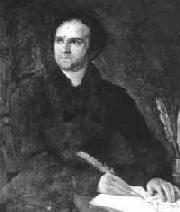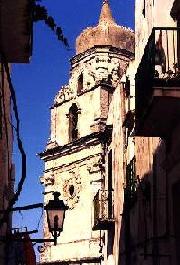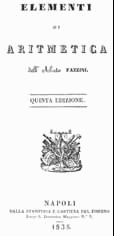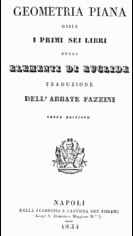L'abate matematico di Vieste
 Amante delle scienze matematiche e fisiche, volle trasferirsi a Napoli per seguire presso l'Università le lezioni di Niccolò Fergola, il grande matematico noto in tutta l'Europa. Qui ebbe modo di seguire con molta attenzione e passione le varie scoperte scientifiche, che venivano effettuate in Italia e in Europa. In quel periodo pullulavano in Napoli un gran numero di scuole private e il nostro Fazzini, appena terminato il corso di studio con il Fergola, ne aprì una con un programma preuniversitario, equivalente grosso modo al nostro liceo, che ebbe a dotare, man mano, di un magnifico gabinetto scientifico, che dopo la sua morte sarà acquistato dall'Università. Vi insegnò matematica, fisica e filosofia e fu molto apprezzato perché aveva egli vasto sapere, severo rigore di metodo, chiara, facile, nobile elocuzione, rapida e lucida maniera di dipingere con la parola le più astruse dottrine, voce grata, sonoro, flessibile ad ogni oratorio movimento. In poco tempo gli uditori crebbero in sì gran numero, che fu mestieri tramutare la scuola in più ampia sala, dove avreste veduto più centinaia di giovani della metropoli, delle province e di lontani paesi stranieri stretti l'uno accanto all'altro e per più ore intenti ad udirlo con religioso silenzio (da "L'abate Lorenzo Fazzini" di F. Dell'Erba in IL GIORNALE D'ITALIA del 23/9/1933).
Amante delle scienze matematiche e fisiche, volle trasferirsi a Napoli per seguire presso l'Università le lezioni di Niccolò Fergola, il grande matematico noto in tutta l'Europa. Qui ebbe modo di seguire con molta attenzione e passione le varie scoperte scientifiche, che venivano effettuate in Italia e in Europa. In quel periodo pullulavano in Napoli un gran numero di scuole private e il nostro Fazzini, appena terminato il corso di studio con il Fergola, ne aprì una con un programma preuniversitario, equivalente grosso modo al nostro liceo, che ebbe a dotare, man mano, di un magnifico gabinetto scientifico, che dopo la sua morte sarà acquistato dall'Università. Vi insegnò matematica, fisica e filosofia e fu molto apprezzato perché aveva egli vasto sapere, severo rigore di metodo, chiara, facile, nobile elocuzione, rapida e lucida maniera di dipingere con la parola le più astruse dottrine, voce grata, sonoro, flessibile ad ogni oratorio movimento. In poco tempo gli uditori crebbero in sì gran numero, che fu mestieri tramutare la scuola in più ampia sala, dove avreste veduto più centinaia di giovani della metropoli, delle province e di lontani paesi stranieri stretti l'uno accanto all'altro e per più ore intenti ad udirlo con religioso silenzio (da "L'abate Lorenzo Fazzini" di F. Dell'Erba in IL GIORNALE D'ITALIA del 23/9/1933). Luigi Settembrini annotò, in un'edizione delle sue RICORDANZE, che a frequentarla erano da 300 a 400 giovani. E la scuola che trovavasi nel 1823 alla Strada Nuova dei Pellegrini, al n. 19, dovette trasferirsi alla via Magnocavallo.
Luigi Settembrini annotò, in un'edizione delle sue RICORDANZE, che a frequentarla erano da 300 a 400 giovani. E la scuola che trovavasi nel 1823 alla Strada Nuova dei Pellegrini, al n. 19, dovette trasferirsi alla via Magnocavallo.Fra i suoi allievi, che si resero poi famosi, sono da citare: il grande letterato Francesco De Sanctis, che lo ricorda sempre con molto rispetto nei Saggi Critici e nell'opera autobiografica La Giovinezza; il fisico, vulcanologo e filosofo Luigi Palmieri; lo scienziato medico Pasquale Manfrè, il chimico Giacomo Paci, Francesco Cirelli, i fratelli De Tommasi, Innocenzio De Cesare, Francesco Costabile.
Lorenzo Fazzini ebbe anche contatti con illustri scienziati, fra cui il toscano Nobili e il francese Arago e fece del magnetismo studi particolari, innumerevoli esperienze, coronate da varie scoperte. Dimostrò errata la teoria dell'inglese Faraday sul Magnetismo di Rotazione (scoperto da Arago), circa l'attribuizione all'elettricità.
Importanti furono le scoperte sulla repulsione tra la luce e il magnetismo, sulla virtù magnetica della terra; il potere del magnetismo terrestre sui corpi non magnetici; i fenomeni dell'attrazione e repulsione e quelli dei conduttori mobili o astatici di Ampère. Aveva apprestato anche un trattato di fisica sperimentale, che, però, rimase inedito ed ora disperso. Fra le pubblicazioni si ricordano gli: Elementi di Matematica, I libri XI e XII degli elementi di Euclide e La Geometria Piana ossia I primi sei libri degli Elementi di Euclide, che tradusse direttamente dal greco.
Morì in Napoli il 4 maggio 1837 stroncato dal colera. A leggere l'elogio funebre fu il purista della lingua italiana, marchese Basilio Puoti, mentre il grande musicista Gaetano Donizetti fece eseguire durante i funerali una Messa in Requiem, appositamente composta per lui. Lo hanno ricordato con scritti vari: Emmanuele Taddei (negli Annali del Regno delle Due Sicilie), i poeti Rosa Taddei, Cesare Malpica, Domenico Simeone Oliva e il comm. A. Spinelli (in Poliorama Pittoresco) e C. Tortora Brayda (ne Il Progresso delle Scienze, delle Lettere e delle Arti).
Gli uomini come Lorenzo Fazzini - ebbe a scrivere il 3 gennaio 1838 Cesare Malpica all'avv. Cesare Riola - non sono mai rimpianti abbastanza e maledetta dal Signore è quella terra ove la memoria de' buoni presto si cancella, e imprecate son le lodi che ad essa si danno.
Napoli, memore di quanto bene fece alla gioventù del suo tempo, gli dedicò una via nei pressi della stazione.
The mathematician abbé from Vieste
Fond of mathematical and physical sciences, he moved to Naples to attend, at the University, the lectures by Niccolò Fergola, the great mathematician known all over Europe.
There, with care and interest, he went after the scientific discoveries made in Italy and Europe.In that period a large number of private schools pullulated in Naples; as soon as Fazzini had completed the course of study with Fergola, he opened a school with a pre-university prospectus, more or less the same as the present grammar school. It was endowed with an excellent scientific laboratory, which would be bought by the University after his death. He taught mathematics, physics and philosophy there and was greatly appreciated, because he was highly cultured, endowed with an accurate method and clear and easy elocution; he was able to describe difficult theories with clear words, and his voice was pleasant, sonorous and flexible.
 In a short time the audience increased so that the school was changed into a larger room, where you could have seen hundreds of young people, coming from big and small towns and from distant foreign countries, listen to him in perfect silence, sitting for many hours (from "The abbé Lorenzo Fazzini" by F. Dell’Erba in IL GIORNALE D’ITALIA 23/9/1933).
In a short time the audience increased so that the school was changed into a larger room, where you could have seen hundreds of young people, coming from big and small towns and from distant foreign countries, listen to him in perfect silence, sitting for many hours (from "The abbé Lorenzo Fazzini" by F. Dell’Erba in IL GIORNALE D’ITALIA 23/9/1933). Luigi Settembrini annotated, in an edition of his RICORDANZE, that his school was attended by 300 to 400 young people. The school, located in 1823 at Strada Nuova dei Pellegrini, 19, moved to Via Magnocavallo.
Among his students, who would have become famous later, we can mention: the great literary figure Francesco De Sanctis, who always makes mention of him very respectfully in Critical Essays and in the autobiographical work The Youth; the physicist, vulcanologist and philosopher Luigi Palmieri; the scientist Pasquale Manfré, the research chemist Giacomo Paci, Francesco Cirelli, De Tommasi brothers, Innocenzio De Cesare, Francesco Costabile.
Lorenzo Fazzini was also in touch with renowned scientists, among whom the Tuscan Nobili and the French Arago, and dedicated himself to the study of magnetism with numerous experiments, completed with various discoveries. He demonstrated that the English Faraday’s theory on Magnetism of Rotation (discovered by Arago), about electricity was wrong.
 His important discoveries were: on the repulsion between light and magnetism, on the magnetic power of the earth; the power of the terrestrial magnetism on non magnetic bodies; the phenomena of attraction and repulsion and of Ampère’s mobile or astatical conductors. He had also prepared a treatise of experimental physics, which, however, remained unpublished and is now missing. Among his publications we can mention: the Principles of Mathematics, the books XI and XII of Euclid’s elements and the Plane Geometry, that is, the first six books of Euclid’s Elements, which he translated from Greek directly.
His important discoveries were: on the repulsion between light and magnetism, on the magnetic power of the earth; the power of the terrestrial magnetism on non magnetic bodies; the phenomena of attraction and repulsion and of Ampère’s mobile or astatical conductors. He had also prepared a treatise of experimental physics, which, however, remained unpublished and is now missing. Among his publications we can mention: the Principles of Mathematics, the books XI and XII of Euclid’s elements and the Plane Geometry, that is, the first six books of Euclid’s Elements, which he translated from Greek directly.  He died in Naples on 4th May 1837, struck by cholera. The purist of the Italian language, marquis Basilio Puoti, read the funeral oration, while the great musician Gaetano Donizetti had a Mass in Requiem performed during his funeral, specially composed for him. He was mentioned in various works: by Emmanuele Taddei (in the Annals of the Kingdom of the two
Sicilies), the poets Rosa Taddei, Cesare Malpica, Domenico Simeone Oliva, A. Spinelli (in Poliorama Pittoresco) and C. Tortora Brayda (in The Progress of Sciences, Letters and Arts).
He died in Naples on 4th May 1837, struck by cholera. The purist of the Italian language, marquis Basilio Puoti, read the funeral oration, while the great musician Gaetano Donizetti had a Mass in Requiem performed during his funeral, specially composed for him. He was mentioned in various works: by Emmanuele Taddei (in the Annals of the Kingdom of the two
Sicilies), the poets Rosa Taddei, Cesare Malpica, Domenico Simeone Oliva, A. Spinelli (in Poliorama Pittoresco) and C. Tortora Brayda (in The Progress of Sciences, Letters and Arts). Such men as Lorenzo Fazzini - wrote Cesare Malpica to the lawyer Cesare Riola on 3rd January 1838 - are never lamented enough and the land where the memory of the good is soon obliterated is cursed by God.
Naples, mindful of how much good he did to the youth of his time, dedicated him a street near the station.
(translated by G. Patrone)